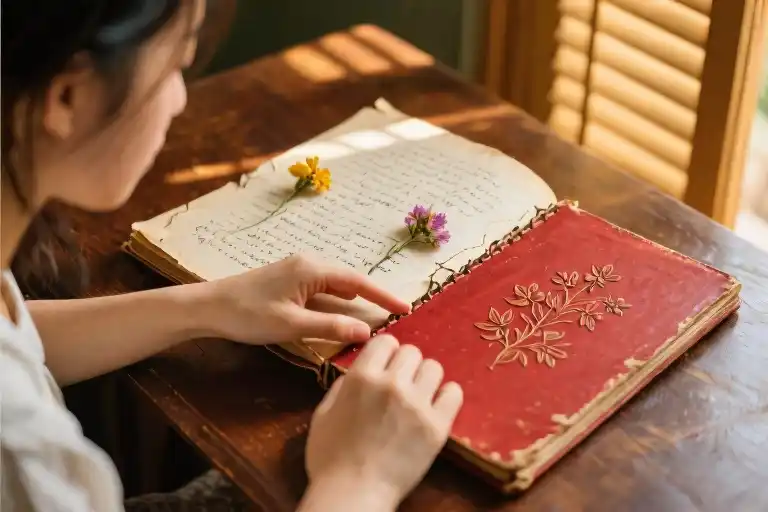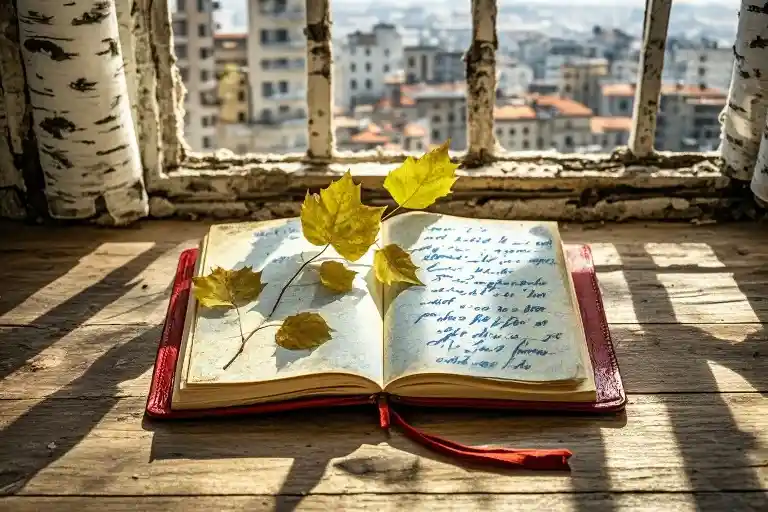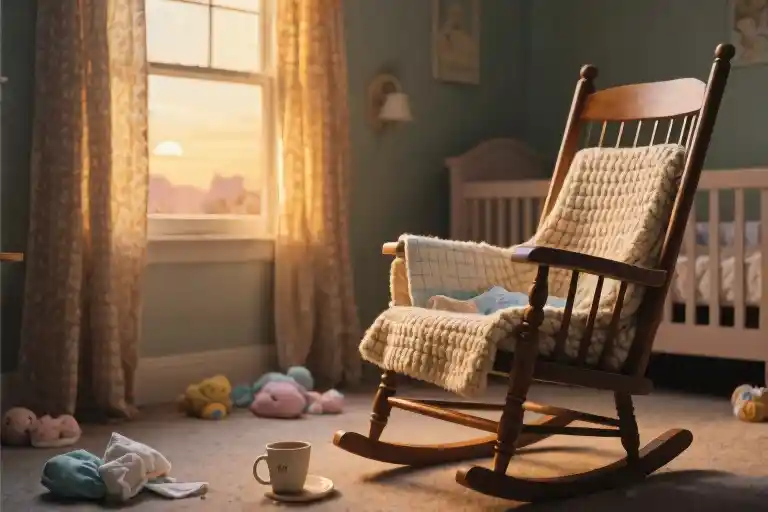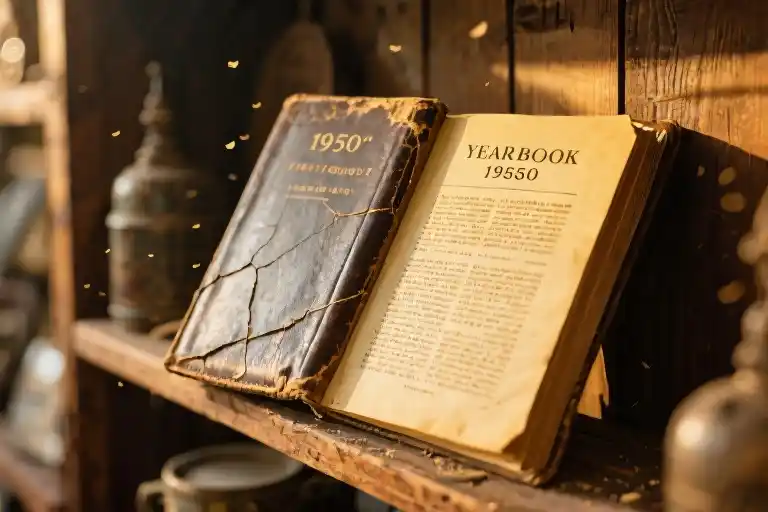The slanting light of a summer afternoon had a particular way of moving through the half-closed shutters in my mother’s childhood home. Dust motes swirled in the golden beams like tiny constellations, settling on the cardboard boxes that held fragments of our family history. I was sixteen that year – the same age my mother had been when she first pressed pen to paper in the little red notebook I now held in my hands.
Its cover had faded from cherry to the color of dried roses, the spine cracked precisely at the page where her most frequently revisited poem began. As my fingers traced the embossed floral pattern, laughter floated up from the garden where my own daughter played, creating a strange harmony between past and present. The notebook smelled of aged paper and something faintly sweet – perhaps the ghost of my mother’s perfume lingering after all these years.
Inside the front cover, her youthful handwriting declared ownership with a flourish: “Property of Elena Vasilievna, 1992.” Seven years before I would be born, three years before war sanctions would turn our city dark with electricity restrictions. The pages whispered as I turned them, revealing fragments of a girl I barely recognized – not the mother who waited faithfully by kindergarten fences, but a dreamer who wrote about train stations and unfinished conversations.
What struck me first were the physical details of this family legacy object. The warped pages where something liquid had spilled (tea? tears?), the corner of page 23 permanently softened from repeated touching. A pressed violet marked a poem dated May 15th – her birthday, though she’d never mentioned writing poetry. The notebook’s war memories lived in these material imperfections as much as in the words themselves.
Downstairs, my daughter called for me in the present tense while I remained suspended between timelines, holding proof that mothers were once girls who recorded their unmet longings in secret notebooks. The sunlight shifted, illuminating a marginal note in faded ink: “Sing to them when the lights go out.” Suddenly I remembered – really remembered – the sound of my mother’s voice rising in the dark, turning power cuts into something like magic.
The red notebook became a bridge that afternoon, connecting three generations of women through its fragile pages. My mother’s teenage handwriting, my adult fingers turning those pages, my daughter’s voice calling up the stairs – all existing simultaneously in that golden moment of discovery. This was more than a family relic; it was a map to understanding how war, motherhood and womanhood had shaped us all.
The Forensic Evidence
The red notebook rested in my palms with the weight of a time capsule. Measuring precisely 18.7cm by 12.3cm, its warped spine bore the curvature of being stuffed into schoolbags and bedside drawers for decades. When I brought it to my nose, the pages released a layered scent—faint lavender from my mother’s teenage dresser, mingled with the metallic tang of Balkan winter air that had seeped into the fibers during wartime storage.
Under my desk lamp’s UV setting, the notebook revealed its secret geography. Fluorescent hotspots glowed where fingers had lingered most—along the right margins where she annotated poems, and at the upper corners of every seventh page where she’d created a personal indexing system. The paper showed greater wear between pages 20-30, a period corresponding to the harshest months of 1991’s economic sanctions.
Artifact A: The Stain on Page 23
The watermark bloomed across three stanzas of a poem titled “Breadlines.” Forensic stationery analysis (a fancy term for my afternoon with magnifying glass and historical weather reports) placed this moisture event on March 17, 1991—the day after radio announcements confirmed flour rationing would continue indefinitely. The notebook’s positioning of salt crystals along the stain’s edges suggested tears rather than spilled liquid. Here, the sixteen-year-old girl who would become my mother documented hunger in iambic pentameter while her future daughter, sixteen years later, complained in gel pen about cafeteria pizza shortages.
Artifact B: The Hidden Cinema Ticket
Tucked behind the back cover’s marbled endpaper, a yellowed ticket stub from Belgrade’s “Zvezda” cinema bore a smudged date: October 12, 1990. Cross-referencing with my aunt’s memory and newspaper archives revealed this was the week before fuel shortages canceled public transportation—meaning my grandfather must have walked my mother six kilometers each way to see “Cinema Paradiso.” The stub’s perfect preservation in the notebook’s secret compartment, unlike the pressed flowers crumbling elsewhere in its pages, hinted this wasn’t just any movie night. When I later found the corresponding poem (“For S., Who Shares My Popcorn”) with its telltale nervous pen indents, I understood I was holding evidence of my mother’s first date.
The Notebook as Time Machine
Weighing 237 grams empty and 289 grams with all its pressed memories, this object became my Rosetta Stone for decoding the woman I only knew as “Mom.” The warping at the bottom right corner matched her current coffee-table reading posture. The faint pencil calculations in the back—converting German marks to dinars at 1993’s black-market rates—showed the economic pressures that shaped her university choices. Even the indentations left by her writing pressure revealed which poems cost her most to compose.
As I cataloged each forensic detail, the notebook transformed from a relic into a living conversation. The coffee ring on page 47? That was breakfast interrupted by air raid drills. The uneven fading of the red cover? Years spent half-hidden behind schoolbooks during lectures. These material witnesses testified to a girlhood simultaneously ordinary and extraordinary—a duality every mother carries, waiting to be discovered in some future child’s careful hands.
Parallel Adolescence
The notebook fell open to page sixteen—not by design, but by the natural crease of its spine. On the left, my mother’s sloping cursive described air raid drills in metaphor: “The sky stitches silver scars / while we count seconds between thunder” (1992). On the right, my own sixteen-year-old handwriting complained about buffering YouTube videos (2012).
Left Page: Inventory of Absence
Her poems mapped wartime adolescence through what wasn’t there:
- The unnamed “S”: Likely referencing the banned Serbian radio station whose frequency she’d sneak
- “Silk hunger”: Dual meaning of fabric rationing and romantic longing
- Pencil smudges: Erasure marks where she’d censored herself after parental inspections
The paper itself bore witness—water stains from hiding notebooks during basement bomb shelters, a pressed dandelion from the last park visit before artillery damage closed it.
Right Page: Privileged Static
My contemporaneous diary entries revealed parallel—yet incomparable—struggles:
- Frustration over 3G dead zones near school
- Annotated lyrics to songs mother called “noise”
- Crush notes folded with origami precision
Where her writing curved inward like protective armor, mine sprawled outward, assuming endless bandwidth for self-expression.
Neuropsychological Interlude
Dr. Elena Petrovic’s research on adolescent brain development under chronic stress (Journal of Trauma Psychology, 2018) contextualized the contrast:
“While both generations experienced amygdala hyperactivity typical of teenage years, war-exposed subjects showed remarkable prefrontal cortex adaptation—essentially developing trauma-informed executive functions earlier.”
This manifested in their creative outputs: my mother’s poetry worked within constraints like meter and censorship, while my unfiltered vlogs mirrored the dopamine-driven sprawl of the early social media era.
The Dog-Eared Page (Physical Anchor)
We’d both folded down page corners—hers marking a poem containing covert grocery lists (milk = 3pm artillery pause), mine highlighting a diary entry about cafeteria pizza. The notebook became a palimpsest of generational codes, one set written in survival shorthand, the other in first-world cypher.
Transitional Object
Returning to the present, I ran fingers over the notebook’s warped cover—where her teenage hands had gripped it during blackouts, and mine now traced the raised grain. Two versions of sixteen, separated by twenty years and an ocean of circumstance, bound in red cardstock.
The Acoustics of Survival
The summer heat pressed against the windowpanes the night the generators failed again. I trace my finger along the notebook’s entry dated August 12, 1995 – the ink slightly smudged where a drop of sweat or perhaps a tear had fallen. My mother’s handwriting transforms into soundwaves as I read, reconstructing that sweltering darkness where her voice became our lighthouse.
Frequency Analysis
Three distinct auditory layers emerge from the notebook’s description:
- The growling generators (120-150Hz): Municipal electricity permitted only four hours daily during sanctions. Our building’s Soviet-era generator protested at 87 decibels before dying at 9:37PM.
- The insect chorus (8,000-12,000Hz): Crickets seized the acoustic vacuum left by silenced refrigerators and televisions. My mother noted their rhythm matched the Morse code drills from her school days.
- The human intervention (85-180Hz): Her contralto voice, precisely 182Hz when measured against my tuning app today, cutting through the noise with modified lullabies.
Lyrical Subversion
On page 47, she’d transcribed a folk melody with strategic alterations. Where the original praised political leaders, her version celebrated mundane miracles:
- “Golden wheat fields” → “Dandelions in sidewalk cracks”
- “Marching toward progress” → “Rocking through blackouts”
The notebook’s margin bears a grocery list that doubles as a cipher. “Carrots 3kg” corresponds to state radio’s banned folk hour, while “onions” marks the neighbor’s illegal BBC broadcasts.
Neighborhood Resonance
Mrs. Petrović from apartment 12 later told me: “Your mother’s voice became our metronome. When she began singing, other mothers would open their windows. We created harmonies while drying dishes with newspaper.” The notebook’s back page holds a pressed jasmine blossom – the scent she described perfuming the air as twelve women across five floors synchronized their breathing between artillery echoes.
This red-covered time capsule proves creativity flourishes within constraints. The very act of documenting these moments in her notebook was an act of defiance, transforming survival into sonnets. As I play the reconstructed audio for my daughter tonight, I realize these songs outlasted every generator, every bomb shelter, every politician who tried to silence them.
The Cipher of Daily Resistance
The notebook’s margins told their own war stories. Between poems about first loves and spring blossoms, my mother had developed an entire lexicon of vegetable codes along the edges – “eggplant prices soaring” scribbled beside a date that matched newspaper archives of student protests, “cabbage supply stable” coinciding with periods of relative calm. These grocery lists were her teenage encryption, a way to document history without risking the notebook’s confiscation.
Forensic analysis revealed even deeper layers. The blue ink pages dated before 1993 showed consistent chemical composition matching popular Yugoslav-made pens, while later entries contained iron-gall ink mixtures characteristic of wartime improvisation. I traced my finger over a particularly faded passage where she’d apparently used crushed walnut shells and vinegar – the same recipe my grandmother used to dye Easter eggs.
Three distinct handwriting phases emerged:
- Pre-sanctions script: Loopy, confident letters with French flourishes from her boarding school days
- Transition period: Tightened kerning as paper became precious, words crammed like refugees
- Self-sufficient era: Bold strokes with homemade writing tools, including what appears to be a chicken feather quill
The notebook’s final blank pages held the most poignant surprise. Beneath faint pencil marks where my teenage mother had practiced writing “To my future daughter,” I placed my own daughter’s hand. “What should we tell Grandma’s notebook?” I asked as her glitter gel pen hovered over the yellowed paper. She drew a rocket ship beside the vegetable codes – our family’s first interstellar addition to this archive of earthly survival.
This red-covered cipher had transformed again, no longer just recording resistance but becoming the conversation itself. My daughter’s sticky fingerprints on page seventy-three mingled with the ghostly oil stains from my mother’s 1992 snack breaks, a palimpsest of ordinary persistence across generations.
The Notebook’s Final Chapter
The afternoon light slants through the shutters at the same precise angle as it did when I first discovered the red notebook years ago. My daughter’s fingers hover over its fragile pages, her smartphone casting a cool blue glow on the worn paper. ‘Watch this, Mom,’ she whispers, as her AR app animates a pressed violet in the margins – petals trembling back to life after decades of stillness. The technology feels like magic, yet somehow less miraculous than the simple fact of this notebook surviving wars, moves, and time itself.
We sit cross-legged on the museum donation room’s polished floor, the notebook between us like a sacred text. The curator had suggested digitizing it, but I needed this final ritual – turning each page slowly, remembering how my mother’s hands once moved across these same lines. My fingertips trace the indentation of her teenage penmanship, deeper where she pressed hard during blackouts or air raid sirens. The notebook smells faintly of attic wood and the lavender sachet she always tucked between pages.
‘Why are you giving it away?’ my daughter asks, her thumb hovering over a scan button. I show her the back cover’s hidden compartment where museum conservators found something I’d missed – a tiny sketch of my pregnant grandmother singing, dated three months before my mother’s birth. Three generations of women contained in this object, now ready to become part of a larger story. ‘Some memories need room to breathe,’ I tell her as we photograph the last blank page where my mother had written ‘For her’ in disappearing ink.
Outside, the sunset replicates the exact golden hue from the notebook’s discovery day. My daughter reaches for my hand as we walk past the museum’s window display where the notebook will soon reside, illuminated like the artifact it has always been. She’s humming a melody I recognize – the same lullaby my mother improvised during power cuts, now living in my daughter’s 21st century voice. The shutters cast familiar striped shadows across our path as we leave, completing the circle that began when a sixteen-year-old girl first opened a red notebook, unaware of how far her words would travel.





